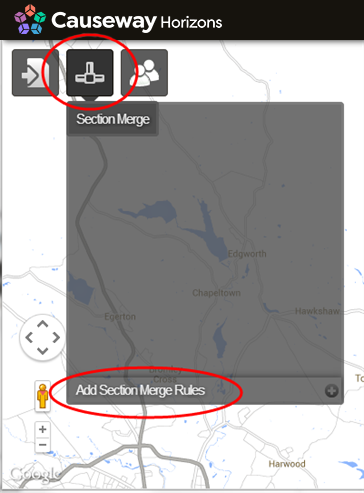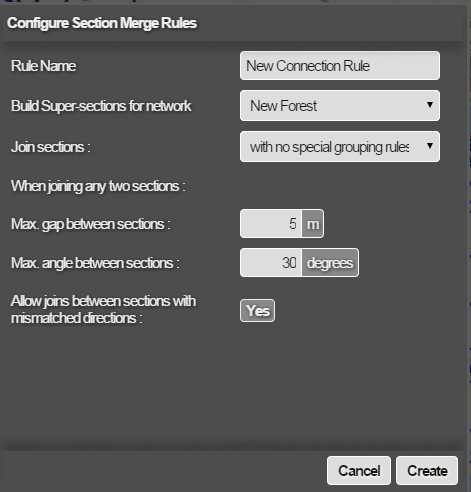Defining a Non-Group Merge
In the merge with no special grouping rules mode, the merge process runs on the whole Network. The system attempts to join all Sections according to the Non-Group Merge connection rules.
Any un-merged Sections remain as a single-Section Super-section in the resulting Section Merge Layer.
In merge with no special grouping rules mode, two nearby Sections are considered for merging if they pass ALL of the rules described in the following table.
Merge With No Special Grouping Connection Rules
- The closest ends of the two Sections are within a certain maximum distance (which you can define)
- The angle of deviation between the two Sections at the join is below a certain maximum angle in degrees (which you can define)
- Optional—The Sections being joined run in the same direction. That is, they are joined start-to-end or end-to-start (which you can define)
In some cases, more than one Section can be considered for joining to the end of another. For example, if a Section ends where two others fork off. In such a case, the two closest Sections with the smallest angle of deviation at the join are merged.
Sections are merged together following these rules until the longest possible Super-section is generated. This is given a unique Super-section ID and is used as input for Analysis. A Treatment can be generated anywhere along a Super-section.
To set up a Non-Group Merge
- In the Management module, click Section Merge and then click Add Section Merge Rules.

The Configure Section Merge Rules window opens.

- Enter a name for the new Section Merge Layer to generate, specify Non-Group Merge Mode, and select the Network that contains the Sections to be merged.
- Complete the following fields (refer to Group merge connection rules above):
Max. Gap Between Sections
Only Sections that have endpoints within this distance of each other are considered for merging. Do not set this too large. Endpoint distance is not used for selecting the best sections to join in cases of ambiguity.
Max. Angle Between Sections
Only Sections that have ends that align within this angle are considered for merging. Set 180 degrees to ignore this rule. Sections are perfectly aligned if the angle at join is 0 degrees. The angle of join is used for selecting the best sections to join in cases of ambiguity.
Allow Joins Across Sections With Mismatched Directions
To allow Sections to be joined that do not match direction (i.e. end-to-end or start-to-start), set to Yes. To prevent this, set to No . Section direction is not used for selecting the best sections to join in cases of ambiguity.
- Click Create.
Horizons generates map tiles for the Layer, which may take a few minutes. The Section Merge Layer is created. You can now view and export the resulting Section Merge Layer, and use it as input to Analysis.